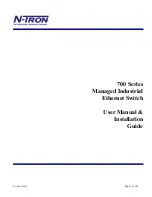
Description
2.8 Power over Ethernet (PoE)
SCALANCE W780/W740 to IEEE 802.11n Web Based Management
Configuration Manual, 08/2018, C79000-G8976-C267-13
37
2.8
Power over Ethernet (PoE)
General
"Power over Ethernet" (PoE) is a power supply technique for network components according
to IEEE 802.3af or IEEE 802.3at. The power is supplied over the Ethernet cables that
connect the individual network components together. This makes an additional power cable
unnecessary. PoE can be used with all PoE-compliant network components that require little
power (max. 12.95 W).
Which Ethernet connectors of a device are capable of PoE can be found in the operating
instructions of the relevant device.
Cable used for the power supply
●
Variant 1 (redundant wires)
In Fast Ethernet, the wire pairs 1, 2 and 3, 6 are used to transfer data. Pairs 4, 5 and 7, 8
are then used to supply power. If there are only four wires available, the voltage is
modulated onto the wires 1, 2 and 3, 6 (see variant 2). This alternative is suitable for a
data transmission rate of 10/100 Mbps. This type of power supply is not suitable for 1
Gbps since with gigabit all 8 wires are used for data transfer.
●
Variant 2 (phantom power)
With phantom power, the power is supplied over the pairs that are used for data transfer,
in other words, all eight (1 Gbps) or four (10/100 Mbps) wires are used both for the data
transfer and the power supply.
Whether a device supports variant 1 and variant 2 or only variant 2 can be found in the
operating instructions of the relevant device.
A PoE-compliant switch can supply the end device either using:
●
Variant 1 or
●
Variant 2 or
●
Variant 1 and variant 2.
Endspan
With endspan, the power is supplied via a switch that can reach a device over an Ethernet
cable. The switch must be capable of PoE, for example a SCALANCE X108PoE,
SCALANCE X308-2M POE, SCALANCE XR552-12M.
Midspan
Midspan is used when the switch is not PoE-compliant. The power is supplied by an
additional device between the switch and end device. In this case, only data rates of 10/100
Mbps can be achieved because the power is supplied on redundant wires.
















































